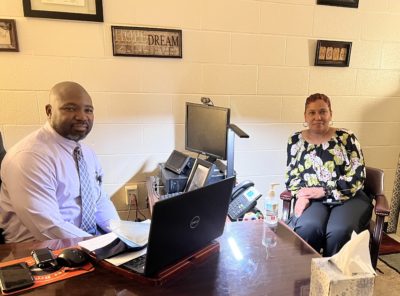
Share this story
- What is a district fund balance and why is it important? We explore that question as well as look at the data for the state's school districts in 2022. Long story short: most districts are doing better than they were in 2019.
- What is a district fund balance? Why is it important? And how are districts faring post COVID-19 when it comes to cash on hand? Your questions answered. #nced
|
|
Most of the available fund balances for the state’s 115 school districts are higher than they were in 2019, according to the most recent data from the Local Government Commission (LGC).
EdNC wrote an article in 2020 looking at district fund balance levels from 2019 to ascertain how well positioned districts were heading into the COVID-19 pandemic. Back then, available fund balances at most districts were lower than they were in 2013.
The LGC — a commission within the state treasurer’s office — annually collects fund balance data for all state school districts. The 2019 data showed that 87 school districts had lower available fund balances than they did in 2013. Only 26 had a higher available fund balance.
In 2022, however, 58 districts had a higher available fund balance than in 2013. And 83 had a higher available fund balance than in 2019. (Information for 14 districts isn’t available, however, to make the comparison between 2022 and 2013, and information for 2 districts isn’t available to make the comparison between 2022 and 2019.)
Here is the data we are using. Take a look.
So what is an available fund balance? And why does it matter?
What is a fund balance?
When we touched on this subject in 2020, we wrote a lengthy explanation of what a district fund balance is and why it’s important. For a full primer, take a look at that article.
If you have $5,000 in your bank account, after you pay your current expenses, you don’t want that balance to drop to zero. Whatever money is leftover in your account after you’ve paid for everything is the available fund balance. That’s my description. The LGC described it as being “essentially the equity in the Local Current Expense Fund,” according to an email from their spokesperson back in 2020.
Think of it as a rainy day fund. In the email from the LGC in 2020, the group said that the available fund balance “is a savings account that schools can use” if unanticipated expenses or opportunities pop up.
The money in these fund balances comes from what the districts get from their county commissioners. It is not the cash they get from the state or federal government. However, money districts get from the state or federal government can make an impact on how much of their fund balances districts end up spending or saving.
In 2020, we also wrote about how much money districts should keep in their fund balances as a percent of their yearly expenditures. We talked to a couple of school finance experts on the subject, and one of them said that 8% was the percentage to aim for.
The LGC disputed that number somewhat, saying that the 8% rule doesn’t exactly apply to schools since they can’t levy taxes. The group’s recommendation was that districts have an agreement with their county about how much their fund balance should be. This is because some county commissioners may be more willing or able to turn over money in the event of an emergency than others. If that’s the case, then the district can probably get by with a lower fund balance.
We took a look then and now at what levels district fund balances were as a percentage of yearly expenditures. Twenty-eight of the state’s 115 school districts had an available fund balance that was less than 8% of their yearly expenditures in 2019. In 2013, that number was 12. In 2022, the number is nine.
We went into detail in our 2020 article about what happened between roughly 2009 and 2019 to account for the changes in available fund balances and fund balances as a percent of expenditure over time.
Going into COVID-19, there was concern about districts’ abilities to weather the storm, but an unprecedented level of federal COVID-19 relief funding helped assuage some of those concerns, as did continued state revenue surpluses.
Given the trajectory of available fund balances held by districts, and the much higher number of districts keeping a fund balance that is 8% or more of its yearly expenditures in 2022, it would seem that things are improving.
Where are we now?
Let’s take a more detailed look at some of the numbers.
For the 2022 fiscal year, fund balances ranged from $106,501,638 at Wake County Schools to minus $114,837 at Clay County Schools. Data was not available, however, for 14 districts.
Of the 101 school districts in North Carolina with data available, only two — Clay and Graham County Schools —had negative fund balances. In 2019, there were six.
A negative available fund balance usually means that liabilities in the local current expense fund outweigh cash on hand. The total fund balance, however, includes assets other than cash. So even if the available fund balance is negative, the total fund balance could still be positive, according to the Local Government Commission. But a negative available fund balance means that a district doesn’t have that extra savings they can spend in the event of an emergency.
Seventeen districts had fund balances of more than $10 million in 2022, compared to only 10 in 2019. Two of the 10 from 2019 — Durham Public Schools and Cumberland County Schools — don’t have data available for 2022.
In 2022, fund balances as a percent of expenditures ranged from almost 373% at Northampton County Schools to minus 7% in Clay County Schools. Clay and Graham both had negative fund balances as well as negative fund balances as a percent of expenditures in 2022.
For more on district fund balances, their importance, and a look at the history of fund balances over time, check out our previous article:
Behind the Story
Katie Dukes helped with the data analysis for this story.
We had incomplete data for the 2019 and 2022 fiscal years. For 2019, two districts had missing data. For 2022, 14 districts had missing data.
Recommended reading




